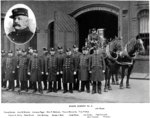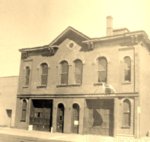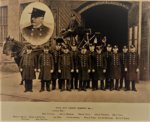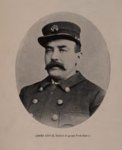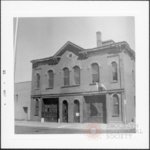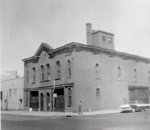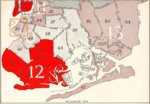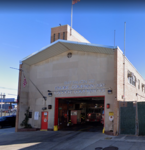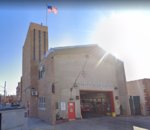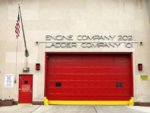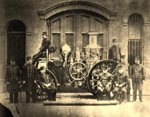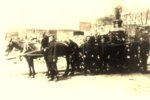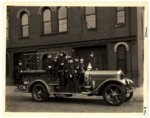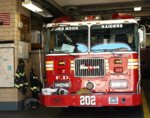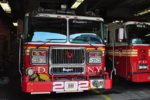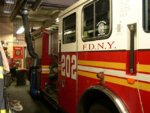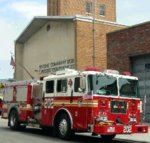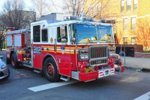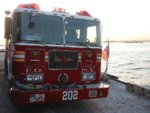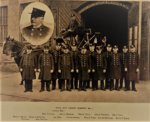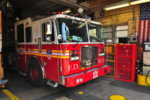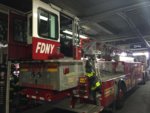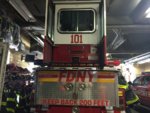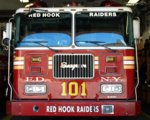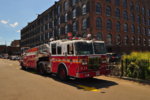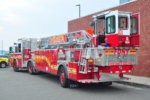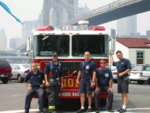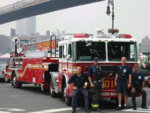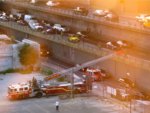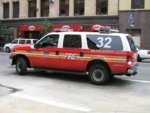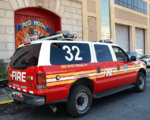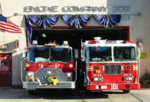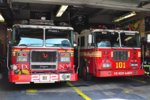Engine 202/Ladder 101/Battalion 32 (continued):
Engine 2 BFD history – later became Engine 202 FDNY:
OUR FIREMEN : THE OFFICIAL HISTORY OF THE BROOKLYN FIRE DEPARTMENT Brooklyn, NY 1892
ENGINE COMPANY NO. 2, OF RED HOOK POINT
ENGINE COMPANY NO. 2. Engine Company No. 2. located at Van Brunt and Seabring Streets, adjoining the house of Truck No. I. was organized when the Paid Department was created. The two-story, brick double house is familiar to thousands of people who have occasion to traverse Red Hook Point. There, for nearly a quarter of a century, the two companies, lying side by side, have protected millions of dollars of property.
The history of Engine No. 2 is the history of the early days of the Department. It is also closely identified with the history of the Twelfth Ward. The residents of that section have long looked upon it as one of their institutions, and without it Red Hook Point would not appear like itself. When the company was first located there, that section was sparsely settled, but it offered admirable facilities for manufacturing purposes. One of the finest water-fronts in the world was the inducement that attracted many large manufacturing firms in New York, and in fact from all over the country, to locate there. Besides that it was within five minutes' walk of Hamilton Ferry. In a short time immense factories and warehouses grew up with surprising rapidity. Now it is by far the greatest manufacturing centre in the city.
Among the large industries that give employment to hundreds, who live in, and go to make up the large resident population of the region, are the stove works of the Richardson & Boynton Company, the factory of the Chesboro Vaseline Manufacturing Company, Worthington's Hydraulic Pump Works, the Pioneer Iron Works, the Lidgerwood Iron Works, the South Brooklyn Machine Company, the India Wharf Brewing Company. J. M. William- son's Drop Forging Works, P. H. Gill's Elevator Works, Casey's Rosin Works, the South Brooklyn Fire Brick Manufactory, and many other large concerns. Besides these are the immense storehouses that line the water-front, including those of the Beard estate, the Robinson estate, the Atlantic Dock Company, the Erie Basin Stores, Findlay's Stores, and the Long Dock Stores.
Added to these are the large ship-building concerns located along the bay, and thousands of vessels, large and small, that are continually loading and unloading their cargoes there. It is estimated that more goods are handled at the Atlantic Dock and Erie Basin than at any other similar places in the country. Recently the Inman and White Star Steamship Companies have purchased property in the district, and before long it will be the headquarters of these and other large lines of transatlantic steamship companies.
When the company was started fourteen reliable and experienced men who had served in the Volunteer Fire Department made up the membership. The present District Engineer of that section, James DOYLE, was placed in charge of the company. He was one of the first Foremen appointed and was known as a fire fighter from the top of his head to the soles of his feet. And what a company it was! Every man was an athlete, fearless and enthusiastic in his new and novel calling. From the old system of the Volunteers to the new system, provided with every improved appliance and contrivance for suppressing fire, was a great change, bid timers tell of the valiant deeds of the original members of Engine No. 2.
"No fire," say they, "could get beyond the control of the boys." The small number of fires, and the comparatively small losses, certainly bear testimony to their efficiency. Under the old regime the company had a large district to cover. Not only was it obliged to cover the Twelfth and Sixth Wards, but its territory included all Gowanus as far as Bay Ridge. Until less than two years ago, when Engines Nos. 1 and 28 were placed in the lower end of the Eighth Ward, the company was compelled to do a great amount of duty. Since then it does not go over the Gowanus Creek unless a second alarm calls, and to a few special boxes. Its district now is bounded by Atlantic Avenue, the water-front, and Gowanus Creek. Altogether the company responds to 44 first alarm calls.
Foreman DOYLE continued in command of the company until his appointment as District Engineer in 1885. The company was known throughout the Department for its skill, and was many times complimented for good work performed at fires; and from this it has in no way retrograded. It still maintains the high standard set years ago, and is improving with the times. Better facilities are provided now than when the Paid Department came into existence.
When District Engineer DOYLE assumed his new duties, the command of Engine 2 was transferred to Foreman Platt VAN COTT, a veteran grown gray in the service. He had served in many companies, and had organized several. He was born at Rockaway, L. I. April 6, 1846, coming of the old Long Island family of his name. Before he attained his majority he came to Brooklyn, and during the war he served in the navy for fifteenth months. At the organization of the Department he was appointed a fireman and assigned to the company in Greenpoint, for three years, after which he was entrusted with the duty of organizing Engine Company No. 15. He started that with all new men and was the acting Foreman of it for seventeen months.
On May 10, 1873, he was appointed Foreman, and continued in command of Engine No. 15. Then he was sent to Truck No. 4, for a year, and from there he went to Truck No. 6, and spent about the same length of time. He was in command of Engine No. 13, for six years, until he was called to Engine No. 2, on Feb. 11, 1886. At the special desire of Commissioner Partridge he organized Engine Company No. 18. He has attended all the big fires and has never met with an accident.
Foreman VAN COTT is of medium height, well built, with an intelligent face and white hair. He is regarded as a strict disciplinarian, but is never harsh. He has in his command a fine lot of men, many of whom, like himself, have served since the Department was organized.
Assistant Foreman JAMES CULLEN is a fine specimen of a fireman. He was born in New York just half a. century ago, but looks much younger. At an early age he moved to this city and settled in the Twelfth Ward. On June 1, 1872, he was made a fireman, but had previously served in the Volunteer Department. His first duty was with his present company, and with the exception of three months he spent as a member of Engine No. 1, he has been a fixture in Engine No. 2 ; as a fireman he ranks with the best. He has had several narrow escapes from death from falling walls, but shows no marks as evidence.
Engineer FRANCIS CURRAN has served in that capacity since the company was organized. Before that he was an Engineer in the old Department. He is regarded as one of the best engineers that ever ran a machine, and can get as much service out of it as any man living. He was born in New York in 1844, but from early childhood has lived in the Twelfth Ward of this city. In stature he is below the average. His dean-shaven, thoughtful face is familiar to everyone in the ward, and there is no one more popular.
JOHN DWYER, the driver, is another old-timer. He was born in New York, in 1844, and was made a fireman, July 1, 1872. When the war broke out he entered the navy and served with credit for two years. He has been connected with Engines Nos. 2, 3, and 4, at different times, mostly as driver, and is in every sense a capable one.
JAMES KEMP was born in Ireland in 1849, and landed in Brooklyn when a youngster. At the age of twenty-one he was made a fireman, his appointment being dated July 20, 1870. Among his colleagues he is justly popular, and by his superior officers he is esteemed for his faithful services and good deportment.
LAWRENCE FAGAN is every inch a fireman. He would rather tackle a burning building than any sort of amusement. Born in this city in 1850, he knows every street and building and is looked upon as a walking encyclopedia. On Feb. 7, 1876, he was appointed a fireman and has done most of his duty with Engine No. 2.
FRANCIS H. MOLLOY was born in this city. Dec. 5, 1850, and was appointed a fireman. Dec. 28, 1876. During his long service he has been in many hot fires and has been complimented several times for heroic service. At a fire in a grain elevator at the Erie Basin in 1879, he had a close call. Just as he with several others, left an adjoining roof, the elevator fell over, striking the spot they had just abandoned. He has assisted in the rescue of several lives, notably among them being the removal of a woman and child from a burning building on Hamilton Avenue.
PETER DUNNE was born in Ireland in 1846, but is a thorough American. He was made a fireman on May 27, 1880, and has distinguished himself on several occasions by his coolness and bravery. Most of his service has been performed with the company he now serves so faithfully.
THOMAS P. SHEA has been a member of the Department and of Engine No. 2 for three years. He was born in this city on Nov. 29. 1865, and was made a fireman on May 20, 1889. He is spoken of as a good fireman, and he looks it.
JOHN MAHONEY is another veteran who has done a good deal of real service and performed it intelligently. He was born in New York City, May 26, 1844, and was made a fireman on June 10. 1870. a few months after the Department was organized. He has served faithfully as a member of several South Brooklyn companies, but for several years has been a fixture in Engine Company No. 2.
WILLIAM P. SKIDMORE was born in this city in 1853, and always had a liking for fire duty. On New Year's Day, 1883. he first reported for duty. Since then he has performed some creditable work and is looked upon as one of the best men in No. 2.
JOHN B. DONOVAN has been a fireman since Dec. 15, 1885, and is as enthusiastic to-day as he was the first day he wore a uniform. Born in this city on June 26, 1859, he knows the territory thoroughly. There is no fire so hot or smoke so dense as to keep him out of a building.
FRANCIS MONNAVILLE was born Jan. 20, 1859, and was appointed a fireman April 1, 1885. He is willing, intelligent and brave, and possesses every requisite necessary in a fireman. Most of his duty has been with Engine No. 2.
GEORGE J. RYAN was born in this city. Nov. 27, 1866 and was made a fireman on Dec. 10, 1891. Although young in years he is old in experience and promises to make his mark in the Department.
MICHAEL QUINLAN was born in Brooklyn on June 3, 1862, and was appointed to the uniformed force on July 1, 1892.
